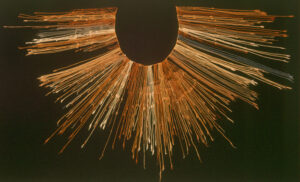The Vikings are well known for the wild tales of Erik the Red and Leif Eriksson. Their adventures and encounters with the strange people and creatures of Greenland, Iceland, and the New World feature prominently in the Norse sagas. However, one worthwhile name often gets lost in the mists: Gudrid Thorbjarnardottir.
This woman was more than a mere supporting character. She was a prolific traveler who made a lasting mark on the New World and Viking exploration as a whole.
Early years
Gudrid Thorbjarnardottir was born in the late 10th century AD. When we first read about Gudrid in The Saga of Erik the Red, she is referred to as “Thorbjarn’s daughter…the fairest of women, and of peerless nobility in all her conduct.” By the end of the sagas, Gudrid’s story takes up over 4,000 words, according to contemporary writer Egill Bjarnason.
This beautiful young woman was the daughter of a chieftain, Thorbjarn of Laugarbrekkamany. Her many suitors, high-bred and low-bred, included one brave slave, who badly wanted to marry her.
She appears again in The Saga of the Greenlanders. Descriptions about her are similar. She had a beautiful singing voice, a graceful demeanor, and diplomatic skills. Although many girls her age focused on marriage and children, she felt a call to explore, like her male counterparts.
From the age of 15, she and her father supported Erik the Red, the notorious explorer who established Greenland’s first European settlement. Scholars attribute her and her father’s support of Erik as crucial to his success.

Erik the Red. Photo: Arngrimur Jonsson’s Gronlandia
The perils of travel did not deter her from staying for months on longboats, amid rampant disease and death. She showed great resilience during the harsh winter travel to Greenland. In one of the sagas, the writer describes a shipwreck she survived.
Another defining trait of Gudrid was her piety. Several references in the sagas indicate her strong devotion to Christianity, which was in its infancy in Iceland. For example, they described her resistance to pagan rituals, in which she stated at a social gathering, “That lore and the ceremony are of such kind, that I purpose to be of no assistance therein because I am a Christian woman.”
She helped establish a church in Glaumbaer, Iceland and she passed on her faith to her son Snorri, whose descendants became famous bishops. Widowed in her later years, she decided to join a nunnery and even traveled to the Mediterranean in her 50s. No Viking had traveled that far.
Misfortunes in love
She married three times. The sagas record her first marriage to a Norwegian man named Thorir, whom she met upon landing in Greenland with Erik the Red. Unfortunately, he died of an undisclosed illness.
Later on, she married Leif Eriksson’s brother Thorstein. Thorstein also died when they attempted to travel with 60 men to Vinland, that Viking settlement area in the New World. According to writer Nancy Marie Brown, going to Vinland might have been her idea.

Leif Erikson. Photo: Hans Dahl (1849–1937)
Her love life seemed abysmal: twice widowed by just 17 years old. However, an instance in the saga speaks of Thorstein temporarily returning from the dead to relay his wife’s future to her. He predicted that she would marry again but should stay away from Greenland men.
The prediction seemed to come true. She did not marry a Greenlander but wed an Icelandic explorer named Thorfinn Karlsefni Thordarson. He was a rich trader and seasoned traveler with whom she traversed the seas past Greenland and safely arrived in Vinland. Her persistence to travel to this land paid off. With him, she had her first child, Snorri. Their son is supposedly the first European born in the Americas.
Life in Vinland
Vinland, or “Wine Land,” is a region along the coast of Canada that Vikings explored and settled 500 years before Columbus. Many believe that the Wonderstrands, a key feature of Vinland described in the sagas, are located on a long, one-of-a-kind beach in southern Labrador, near the town of Cartwright. However, the acidic soil has not preserved any artifacts.

The Wonderstrands, Labrador — the likeliest location for the long beach referred to in the sagas. Photo: Jerry Kobalenko
The one incontrovertible proof of Viking activity in the New World is the settlement at L’Anse aux Meadows on the island of Newfoundland. Here, carbon dating of artifacts corroborates the timing of the sagas as well as Gudrid’s journeys. Items from L’Anse aux Meadows, including spindle whorls, strongly suggest that women lived here too.
Getting to Vinland was a top priority for Gudrid. Gudrid, her third husband Thordarson, and her family lived there with other residents for approximately three years. During this time, Gudrid had good relations with the native peoples called skrælings. Despite the civility between the two, the skrælings did not take kindly to the Vikings in general, engaging in conflict which effectively drove the Europeans from their idyllic beginning in the New World.

The replica Viking village at L’Anse Aux Meadows, Canada. Photo: Jerry Kobalenko
After Vinland, they returned to Iceland where they settled on a farm called Glaumbaer. There, her son Snorri erected the first church. When her husband died, she did not remarry but chose to embark on a pilgrimage to Rome. She then became a nun for the rest of her life.
Nancy Marie Brown states that Gudrid traveled the North Atlantic eight times, making several journeys from Iceland to Greenland to Canada.
Legacy
Even though historians take the Norse sagas with a pinch of salt, due to their tendencies to mix fact with fiction and fantastical elements, they are important to our understanding of Viking exploration. The sagas paint a picture of a young woman who did not let life’s trials stop her.
Her son Snorri became an iconic historical figure in Iceland. Archaeologists discovered remains of his dwelling place in Glaumbaer in 2002. The evidence in Iceland and Canada compliment the sagas’ tales about Gudrid and her family. In the end, Gudrid became one of the most traveled women of her time.






